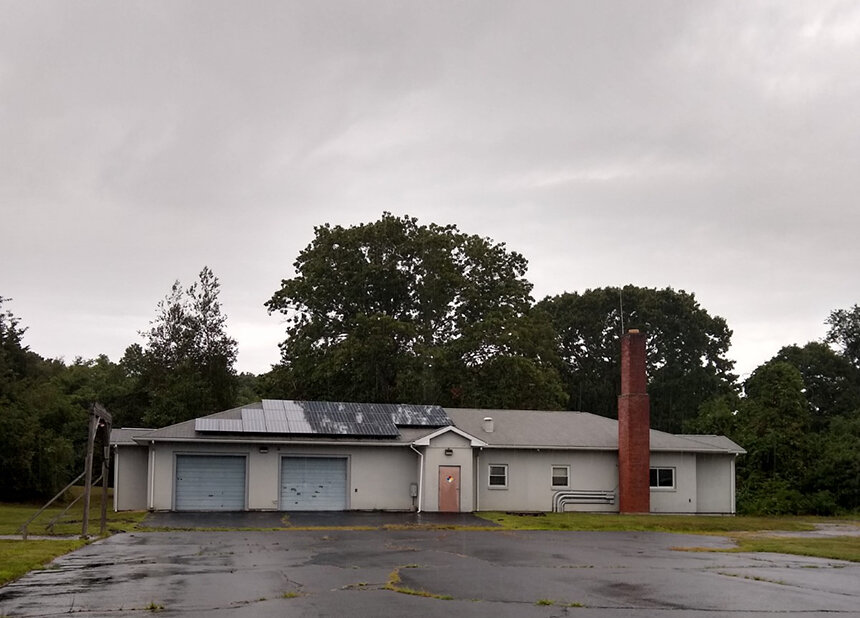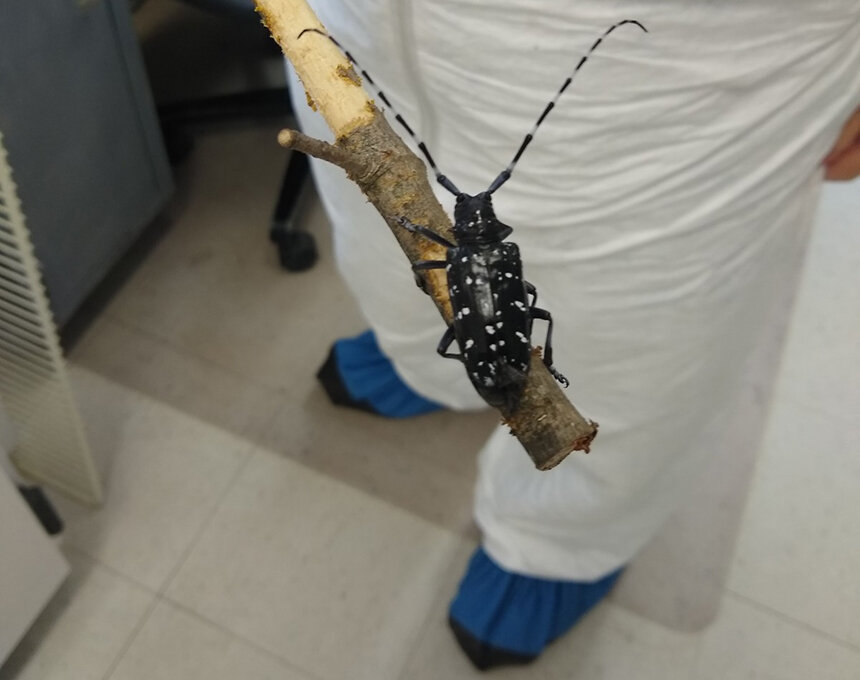Entomologist Keeps Watch Over Quarantined Insects
Connecticut facility houses some of southern New England’s biggest pests
September 10, 2020
ANSONIA, Conn. — Tucked behind a residential neighborhood on Ford Street, is a quarantine facility. Drive up, and a chain-link gate bars your entry. With admittance, you enter a courtyard with three gray buildings. Potted tree of heaven saplings are clustered near the far side of the first building. Other than that, the only sign of life is a glimpse here and there of a figure swaddled in a Tyvek suit moving beyond one of the windows.
Inside, the air pressure drops steadily to help prevent contaminated air from escaping, and my guide Melody Keena, a research entomologist, opens a chamber that houses some of the living specimens. The dead ones are stored in large freezers.
“My technicians probably say that I keep too many of the dead ones,” says Keena with a chuckle as she opens a chest freezer filled with corpses.
She pulls out a pint container, opens the lid, and reveals just what this quarantine facility is hosting. Inside the container are the bodies of a dozen or more adult gypsy moths.

The 14-acre compound that makes up this U.S. Department of Agriculture (USDA) Forest Quarantine Facility specializes in the study of invasive insects. It has been quietly working with various species for the past 28 years.
“This used to be a military facility, specifically a [Project] Nike missile radar site,” Keena says. “And when the military decided they didn’t need it anymore, the Forest Service took it over in the ’80s.”
It wasn’t until 1992, though, that it became specifically used as an insect quarantine facility, where researchers like Keena can observe invasive species’ growth, habits, diets, and behaviors.
“Until about two years ago, this was the only USDA forest operated quarantine facility in the continental U.S.,” Keena says.

When Keena arrived nearly three decades ago, the species du jour was the gypsy moth. To date, other pests quarantined and studied include the emerald ash borer, spotted lanternfly, and the Asian long-horned beetle.
“There aren’t too many facilities that are permitted to work on the same insects that we work on here,” she says.
Each species has its own history, presents its own problems, and has it owns quirks that give Keena and her team plenty to do, but it’s clear bugs — “insects,” she corrects — are her passion.
We enter one of the nondescript buildings and go through a series of dark rooms designed to prevent any stowaways from escaping.
“This is an airlock system, a series of two rooms that are dark,” says Keena as we enter a third room with a large three-paneled mirror. “It’s dark because insects are attracted to lights, so if they made it that far, they’d have to go through this extra layer of protection to get out.”
We suit up in Tyvek coveralls and booties and head in to see some of the most harmful invasive insect species that have made their way to the United States.
First up: the big and beefy Asian long-horned beetle.
“We got this particular insect because China had cut down a lot of their trees and this insect just lived in the natural forest. Nobody cared about it. It wasn’t in any high numbers, wasn’t doing any damage,” says Keena as she shows a few dead specimens in a clear glass box.
“But then a little over 50 years ago, China started to grow timber, and they planted hybrid poplars and willows in large monocultures, and about that size diameter tree of hybrid poplars is very attractive to this insect, so it left its native place of rest and moved into these tracts of new trees and started putting holes in them.”
The wood became full of these big beetles who burrow inside to lay eggs, and when they hatch, the fledgling beetles bore large holes into the wood as they emerge.
“So, China has this timber that they wanted for other things, but it was holey, and so the only thing they could do was to sell it in pack material pallets,” Keena continues. “If you don’t ensure the the larvae are dead that are in the wood, the larvae can survive and move around the world.”
And so it was that the beetle made its journey across oceans and was first spotted in New York in 1996, where the person who discovered the white-speckled black beetle first thought someone was vandalizing his trees with a drill.
“That’s the first group and their story. They all have stories,” says Keena, as we head deeper into quarantine.

Here, in quarantine, live insects are stored in various chambers that mimic the seasons, like the dog days of summer and the mild temperatures of spring.
Keena opens one refrigerator that is set to 10 degrees Celsius (50 degrees Fahrenheit). It houses a few citrus long-horned beetles — a close relative of the Asian long-horned beetle — in jars with twigs and sticks. She pulls out a jar to examine one of them.
“These are female beetles in here, and at this temp they can live for about 300 days. They really live a long time. They don’t lay at this temperature, but they do eat,” she says turning the jar to show a section of branch where the bark has been nibbled away. “I’m just waiting for them to die to finish that study.”
We visit some of the facility’s other specimens, including two nymph spotted lanternflies and dozens of gypsy moths hailing from around the world.
“I have about 60 different strains from around the world that I’ve worked on,” Keena says. “We’re looking at flight capability, susceptibility to microbials, host preferences, a bunch of different things.”
The gypsy moth, a devastating invasive species that has defoliated an estimated 2 million acres of trees in southern New England, was brought to the United States 150 years ago.
“The ones we have came into this country because of an amateur scientist named Léopold Trouvelot,” Keena says. “He brought them into his home near Boston back in 1869, and they escaped from his house.”
Trouvelot, an amateur lepidopterist — moth and butterfly scientist — who lived in Medford, Mass., was experimenting with silk production from captive gypsy moths when he inadvertently let some of the more than 1 million gypsy moth larvae he kept in his backyard escape, according to a story published three years ago in the Vineyard Gazette.

The latest resident of the USDA quarantine facility is the spotted lanternfly, a species that sucks the sap out of trees and grapevines and leaves a sticky layer of “honeydew” in its wake.
“Let me show you because it’s spectacular,” says Keena, pulling out her phone. “I have a video that I took of them in Pennsylvania on maple. It’s not a simple drip, drip, drip honeydew; it’s projectile.”
The video shows the spotted lanternfly, which looks like a colorful moth. As it sucks on the sap of the tree, you can see the liquid zapping out of its behind.
“That’s the extra sap that’s going through them that they’re sucking out of the tree,” Keena says. “It’s sugary, and mold likes to grow in it. It makes for a very slippery situation.”
The tour ends with a rummage through freezers containing various insect specimens. We then head over to a refrigerator set to a warm temperature to see another citrus long-horned beetle.
Keena pulls a large twig out of a jar to examine the female beetle sitting on it.
“This is a girl. They give you fair warning before they fly,” she says, sensing my obvious squeamishness to the pretty big beetle. “They wag their antennae and lift their hard outer shells before they fly. She’ll give you warning.”
The insect seems to stare out intently but made no move to leap into the air.
“She’s being a very good showoff here,” says Keena as places the citrus long-horned beetle back in the jar, back into the fridge, and back into quarantine.
Though Keena sees thousands of insects through their life cycles, from larvae to pupae to adult to dead body, she treats each as an amazing specimen with a personality. She has been fascinated by them since she was a child.
“I got interested in entomology when I was a kid. We used to have fence lizards for pets, and they eat insects, so we had to catch live insects,” Keena recalls. “And then I got curious about the insects, too.”



